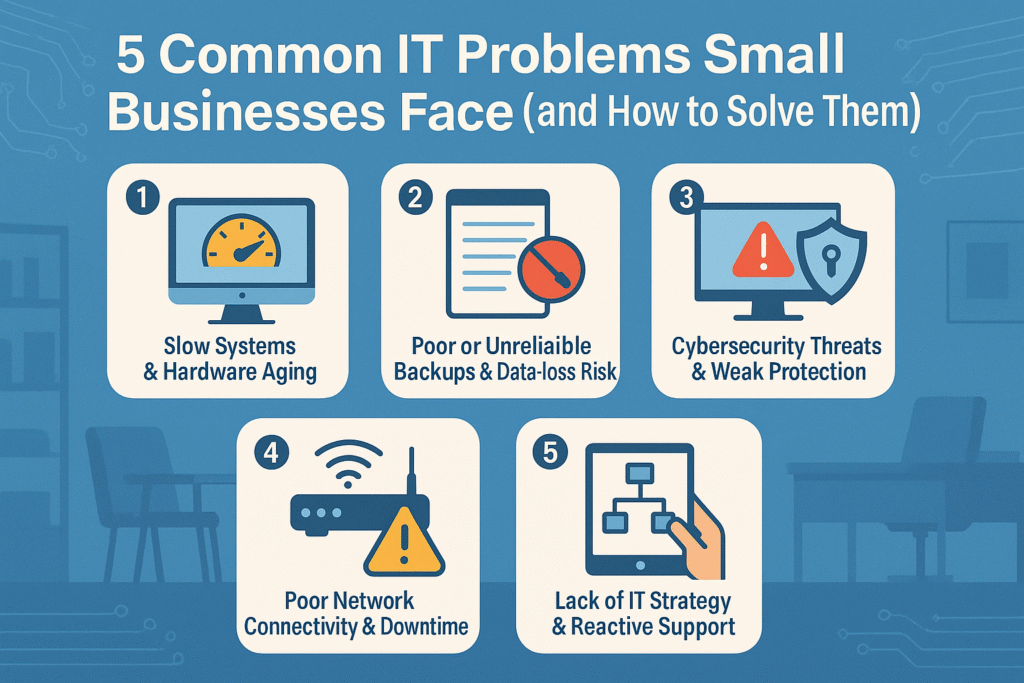In today’s fast-paced business world, reliable technology isn’t optional — it’s essential. Yet for many small and medium-sized businesses, managing IT in-house can quickly become expensive, unpredictable, and time-consuming.
That’s where Managed IT Services come in. Instead of reacting to problems as they happen, managed IT takes a proactive approach — preventing downtime, optimising performance, and ultimately saving your business money every month.
Let’s break down how it works.
1. Reduce Downtime (and Lost Productivity)
Every minute your systems are down costs you money — whether it’s staff unable to work, lost sales, or missed customer calls.
Unplanned downtime often stems from preventable issues like outdated software, neglected backups, or unnoticed hardware faults.
How Managed IT Helps:
-
Continuous monitoring spots issues before they cause outages.
-
Regular updates and maintenance keep systems running smoothly.
-
Fast response times mean problems get fixed before they spread.
🟢 Result: Less downtime, happier staff, and a predictable workflow.
2. Predictable, Fixed Monthly Costs
With traditional “break-fix” IT support, every repair or emergency callout comes with a new invoice. That makes budgeting difficult and can lead to nasty surprises.
How Managed IT Helps:
-
You pay a fixed monthly fee that covers maintenance, monitoring, and support.
-
No unexpected repair bills — just one predictable cost.
-
Easier to forecast expenses and manage your cash flow.
🟢 Result: IT becomes an affordable, consistent part of your business budget.
3. Extend the Life of Your Hardware
Old or poorly maintained equipment slows down productivity and increases replacement costs.
How Managed IT Helps:
-
Regular health checks and updates extend the lifespan of computers, servers, and networking gear.
-
Preventative maintenance keeps hardware performing like new.
-
Strategic upgrade planning ensures you only replace equipment when it’s truly necessary.
🟢 Result: You get more years of value out of your existing assets.
4. Improve Security and Avoid Costly Breaches
Cyber-attacks are expensive — not just in recovery costs, but in downtime, lost trust, and potential legal issues.
How Managed IT Helps:
-
Keeps antivirus, firewalls, and software patched and up to date.
-
Implements data backups and recovery plans.
-
Trains your team on phishing and security best practices.
🟢 Result: Your business avoids expensive breaches and compliance penalties.
5. Boost Productivity with Expert Support
When staff get stuck with IT issues, productivity stalls. Waiting for an external technician to arrive wastes even more time.
How Managed IT Helps:
-
Access to a helpdesk or remote support whenever needed.
-
Issues are solved quickly, so employees can get back to work.
-
You benefit from professional advice on improving efficiency with new tools and automation.
🟢 Result: A more efficient, tech-savvy workforce that works smarter, not harder.
6. Focus on Growing Your Business
Managing IT internally takes time away from what matters most — serving customers and growing your business.
How Managed IT Helps:
-
Frees up owners and managers to focus on operations, not troubleshooting.
-
Offers strategic guidance to align technology with your business goals.
-
Scales easily as your company grows — no need to constantly recruit IT staff.
🟢 Result: You save time, reduce stress, and grow faster.
Final Thoughts
Managed IT services aren’t just about keeping your computers running — they’re a cost-saving strategy that protects your business, your people, and your profits.
By partnering with a proactive IT provider, you turn unpredictable expenses into steady, manageable costs while avoiding the far greater price of downtime or data loss.
If you’re ready to see how much you could save each month with managed IT support, contact Genius Creative today. We provide reliable, affordable IT solutions for small and medium-sized businesses across Sutton Coldfield and the West Midlands.


